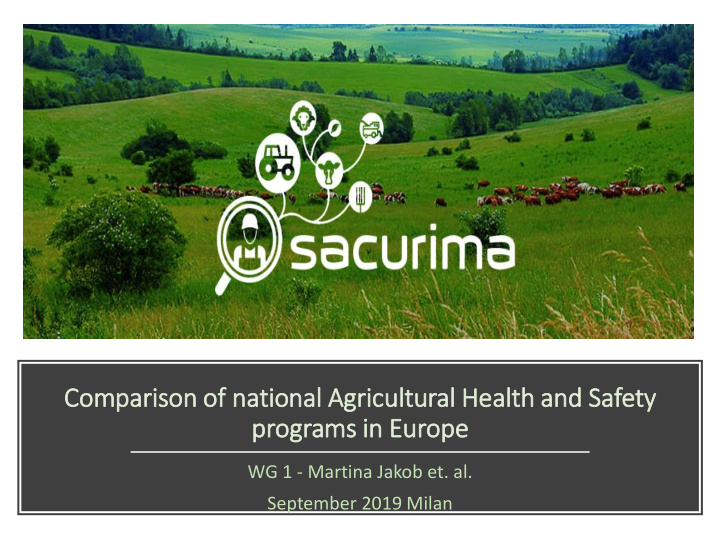



Co Comparis ison of f natio ional l Agri ricult ltural l Healt lth and Sa Safety programs in in Europe WG 1 - Martina Jakob et. al. September 2019 Milan
Legal requirements International Labour Organisation ILO: International Safety and Health in Agriculture Convention, 2001 ILO Convention C184 - So far, only 16 countries ratified the convention EU: European guideline 89/391 and others European - All member countries transposed the directive into their national legislation! National 19 member states implemented more detailed requirements*. * https://eur-lex.europa.eu/legal-content/EN/NIM/?uri=CELEX:31989L0391 24.09.2019 2
24.09.2019 3
General obligations based on EU directive 89/391 Risk assessment Documentation of risks Information of workers Prevention of accidents and diseases 24.09.2019 4
Definition - What does Safety Program mean? Safety programs provide guidelines that direct procedures and include checklists that can make work environments safer by preventing mishaps. Workers are required to know safety procedures that need to be followed in their specific department or area.
Safety programmes in Europe A comparison of safety programmes could be by: 1. Initiating authority (H&S authority, extension service, social insurance) 2. Hazard (pesticide, animal handling, etc.) 3. Tool used to reduce the risk (guideline, checklist, poster, etc.) 4. Implementation level in education/ structure 5. Accessibility (free, comercial, membership) 6. Single-multiple topic adressed (complexity)
Collection of safety programs from the survey WG 1 carried out (question 11): • According to the survey many EU member countries have iniatives to improve H&S • Publication (planned by WG 1)
Evaluation of OHS interventions • There are numerous examples from all over the world promoting H&S, but they were rarely evaluated on their effectiveness. • There are also a number of reviews on H&S. • Apart from the effectiveness, development and implementation also need to be evaluated. Norway: a course on OHS for farmers was evaluated (Holte & Follo 2018) Germany: Evaluation of an ergonomic intervention in dairy parlors (Jakob 2018)
Conclusions • Large variety of national institutional frameworks exists. • The effect of H&S programs is unclear (i.e. Leppäla 2016) due to a lack of evaluation studies. • There is a lack of control variables (i.e. accident numbers) • Often interventions are multiple approaches and it is impossible to follow up the effect of a single change. • Working groups need to collaborate to find ways to measure the effectiveness of H&S programmes. • An evaluation of existing H&S programs needs continous and reliable data collection!
Thank you for your attention!
Recommend
More recommend